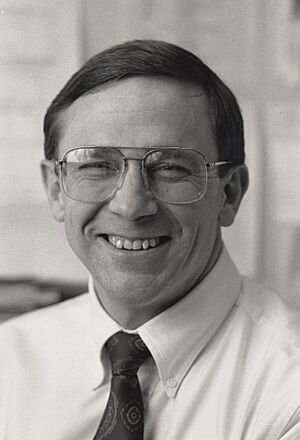Stanley J. Korsmeyer facts for kids
Quick facts for kids
Stanley J. Korsmeyer
|
|
|---|---|

Korsmeyer in 1992
|
|
| Born | June 8, 1950 Beardstown, Illinois, U.S.
|
| Died | March 31, 2005 (aged 54) Boston, Massachusetts, U.S.
|
| Education |
|
| Known for |
|
| Spouse(s) | Susan Reynard |
| Children | 2 |
| Awards |
|
| Scientific career | |
| Fields | |
| Institutions |
|
Stanley Joel Korsmeyer (June 8, 1950 – March 31, 2005) was an American scientist. He studied how cells grow and die, especially in relation to cancer. He was born and grew up in Illinois, U.S.
Korsmeyer spent most of his career as a professor. He worked at Washington University School of Medicine and later at the Dana–Farber Cancer Institute. In the early 1980s, he became well-known. He helped find the genetic cause of a type of cancer called follicular lymphoma. This was linked to a gene called Bcl-2.
Korsmeyer's research showed that if cells don't die when they're supposed to, it can lead to cancer. This was a big discovery! He wrote over 250 science papers. At 45, he was chosen for the U.S. National Academy of Sciences. Korsmeyer passed away in 2005 at age 54.
Early Life and Learning
Stanley Joel Korsmeyer was born on June 8, 1950. His parents, Willard and Carnell Korsmeyer, were farmers. They raised pigs in Beardstown, Illinois. Stanley, who liked to be called "Stan," was interested in being an animal doctor.
He was very active in his local 4-H club. When he was 14, two pigs he raised won a big award. They were named grand champions at the Illinois State Fair. He was the youngest person ever to get this honor. A local animal doctor, Robert Goodin, told him to think about a career in biology instead.
Stan studied biology at the University of Illinois Urbana-Champaign. He earned his degree in 1972. Then he went to medical school at the University of Illinois College of Medicine. There, a doctor named Paul Heller saw his talent. Heller encouraged Stan to become a research scientist.
Stan's first research experience was with Robert Strickland. This led to his first science paper in 1975. He finished medical school in 1976. Then he moved to the University of California, San Francisco for his medical training. In 1979, he joined the U.S. National Institutes of Health.
Working with another group, Korsmeyer found a key genetic change. This change caused most cases of follicular lymphoma. He named the gene involved Bcl-2.
Discoveries in Cancer Research
In 1982, Korsmeyer became a senior researcher. He worked at the National Cancer Institute. A few years later, in 1986, he moved his lab. He went to Washington University School of Medicine. There, he became a professor. He also led the medical oncology division.
His team kept studying B-cell lymphomas. They found that if mice had too much Bcl-2 in their B cells, these cells lived too long. These long-lived cells could then get other changes that led to cancer. This was the first time scientists saw that problems with cell death could cause cancer. Before this, they mostly thought cancer was caused by cells growing too much.
Korsmeyer's group also found that Bcl-2 is important for normal B- and T-cells. These are types of immune cells. In 1990, his team discovered that Bcl-2 is usually found in mitochondria. Mitochondria are like the powerhouses of cells. This discovery led to more research. Scientists wanted to know how mitochondria control cell death.
His team then figured out how mitochondria affect apoptosis. Apoptosis is programmed cell death. They found that Bcl-2 and other related proteins control this process. Korsmeyer created a "rheostat model." This model explained that cell death is controlled by the balance of proteins that cause death and proteins that stop death. His team showed that cancer cells could be killed. This could happen by blocking the anti-death protein Bcl-2. Or it could happen by activating a pro-death protein called BAX.
In 1998, Korsmeyer moved to Harvard Medical School. He became a professor there. He also directed a program at the Dana–Farber Cancer Institute. His group kept studying how mitochondria control apoptosis. They found how Bcl-2 stops other proteins from starting cell death.
This work also showed that these proteins do more than just control cell death. Korsmeyer's team found that BAX and BAK help keep calcium levels right in cells. They also found that another protein, MCL1, is important for blood cell development.
During his career, Korsmeyer published over 250 science papers. Many of these papers were cited by other scientists hundreds of times. Forty of his students went on to become professors themselves. Korsmeyer was chosen for the National Academy of Sciences when he was 45. He also joined other important science groups.
He received many awards for his research. One award, the American Society for Clinical Investigation ASCI Award, was renamed in his honor in 2006. Washington University also started a yearly lecture series in his name.
A colleague, Robert Horvitz, said Korsmeyer was "everybody's hero." He called his work "truly major and pioneering."
Personal Life
While training in San Francisco, Korsmeyer met Susan Reynard. She was a nurse who worked with cancer patients. They got married and had two sons. He loved sailing and fishing throughout his life.
Korsmeyer was diagnosed with lung cancer in early 2004. Even though he was sick, he kept working in his lab. He passed away on March 31, 2005, in Boston, Massachusetts.


